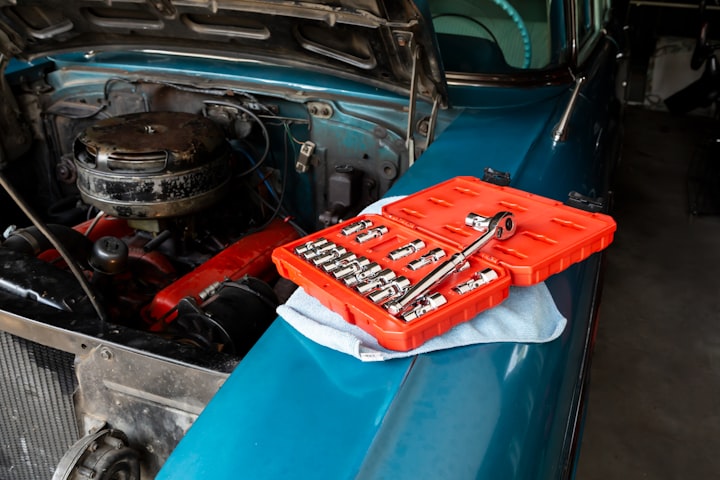Cars
From a first year automotive technician student
From point A to point B, it gets us to and from. But did you know there was a point C?
Point C is the automotive shop/mechanic. The emissions testers, the dealership warranty shop, the tire shop, the alignment rack, the oil change place. If you've guessed it by now, you're right, cars need to be maintained.
Maintenance is important because it helps keep our vehicles/mode of transportation in tip-top condition and safe to drive. Not only does it keep you safe if your car is well-maintained, but it keeps others on the road safe too. If you want to get even more technical, having a well-maintained car can even keep the world a safer place to be in.
Keeping oil leaks off the road, coolant from being burned, exhaust gases from being too polluted, there are many aspects of a car one has to think about before simply driving one. Sure, you get in and start the car and drive. But not before unlocking the vehicle, opening the door, adjusting your mirrors and seat position, putting the seat belt on, checking to see if you've got enough fuel, turning over the starter motor, checking to see if the engine even sounds like its idling properly.
You need to do a lot of things before you actually get moving. And now-a-days, vehicles are becoming more and more resilient, requiring fewer maintenance intervals in-between. The need for newer innovation is a major driving factor for this, and part of it comes from professional racing. Formula 1 to be exact, teams develop their best competition-grade race cars based on set rules that have been determined by the authoritative body behind the popular sport before the season begins. Technology is implemented, reviewed, shared, tested, and abused before one day possibly trickling down to the consumers market of vehicles.
With the advent of hybrid, and then ultimately electric cars, come Formula E. The electric racing league that compliments Formula 1. Basically the same thing, but electric with rules and regulation that would best fit for pushing the limits of the electric motor and its supporting technologies.
The main focus of this article was to shine a light on keeping your vehicle safe to drive, so before we get off topic, I'd like to share with the reader that I volunteered to be elected as class ASB president in the technical school I had attended for automotive technician. I had a deep passion for cars, and peoples love towards their own vehicles, making it their own unique ride, new cars, old cars, race cars, luxury cars. I loved it all. I had no prior leadership experience before this, and I won the election just barely, 11 to 9. I remember I had prepared a power point-like presentation to the class. I remember spending a lot of time on it, to make it look good and not boring.
So you could say that I have at least the slightest bit of credibility when I talk about these things. I hadn't agreed on attending the program for the 2nd year, as I've learned some interesting things about career outlooks, and at the time, I guess I was only focused on the short-term. New innovation driving cars to be more resilient and strong, pushes shop owners to keep more of the money to themselves than to their technicians and mechanics. Not sure where I got this statistic from, but back in the day, it would usually be like 50/50 split or somewhere close to the owner and their employees, but now-a-days its more like 80/20. Instantly, I started looking for a new career while still deciding to learn about cars and how to fix and maintain them.
I'm afraid that sweeping changes to the automotive industry will overwhelm shops and may reduce technician salaries even further due to the need for on-going work shops for continued education to help deal with the new influx of aging electric cars and new innovation/technology that is out on the road today for example. In a hybrid vehicle, there's a color-coded wire inside the engine bay that all technicians are taught as extremely dangerous and potentially lethal if improperly handled. The orange wire is a thick-gauge insulated wire running from the battery to the electric motor, and last I checked, there's about 40-60 amps running through it when its live. You wouldn't want to touch that wire especially if it was bare, it would be very bad.
I guess the reason I'm writing this article is because I wanted to address the maintenance aspect of owning a vehicle. I'm tired of hearing the screeching sound of a slipping timing belt in the mornings in my apartment, the smell of gas in exhaust plumes indicating that it's running rich, broken speedometers, faulty thermostats, etc.
Anyway, I've just had it with the neglect of peoples vehicles and I want to start a call-to-action to get everyone's vehicles in better shape. So go out and schedule an appointment with the shop, do some research, go to the junk yard and pick n pull, buy some tools, buy some air freshener, buy some seafoam, fuel injector cleaner, brake pads and rotors, buy more window-washer fluid, buy anything and everything, just take care of your babies for me, will ya?
About the Creator
Davis Nguyen
He considers himself a novice writer. Living in the greater Seattle area, a high school drop out. With no academic credibility, he sets out a journey to the center of his insubordination in hopes to 1 day earn an honest living wage from it.







Comments (1)
Great work !